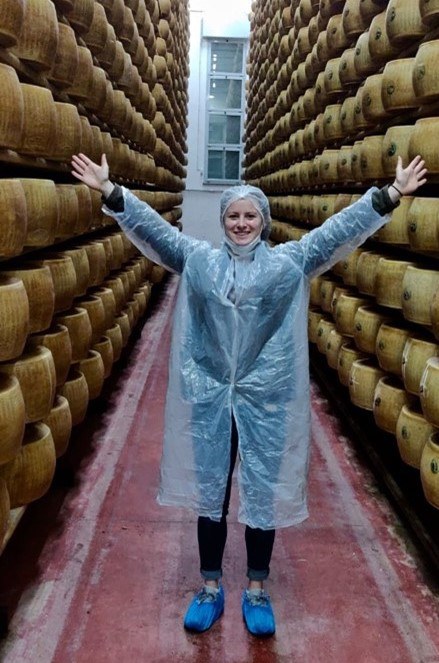Posted: September 15, 2020
Food and food production are a means of uniting people and culture.
Ever since setting foot on the Penn State campus, I knew that I wanted to have study abroad be a portion of my educational experience. During senior year I finally got my opportunity. Better yet, the whole focus of my abroad program was around my major – Food Science.
Over spring break, I along with twenty other students majoring in Food Science, travelled to the Emilia-Romagna and Piemonte regions of northern Italy to study Italian food production. The trip was a Food Science major's paradise. Over the course of the week, I had the opportunity to visit the production facilities for balsamic vinegar, Parmigiano-Reggiano cheese, Prosciutto di Parma ham, Barolo wine and Ferrero Rocher chocolate. Here's a taste of what I learned:
Balsamic vinegar: Balsamic vinegar is a dark, concentrated product made from grape must. Our group quickly found out that the time it takes to enjoy balsamic vinegar is much faster than the time to age it – it takes at least 30 years to get a thick, sweet product!
Parmigiano-Reggiano cheese: This is not the parmesan we put on our spaghetti! It takes 600 liters of raw milk to product two wheels of Parmigiano-Reggiano cheese. The cheese is made in a large, copper cauldron. Rennet is added to the milk with heat so that the cheese curds can settle to the bottom of the cauldron. Eventually, these curds will form the classic wheel shape. It will take another 3-7 years of ripening to officially call this cheese Parmigiano-Reggiano.
Prosciutto di Parma ham: Another Italian specialty. Prosciutto is a dry-cured ham from the hind leg of pigs. The meat is dried with salt and allowed to cure at cool temperatures for at least 9 months, but curing could last for 2 years. Serve with a glass of Barolo wine for a delicious aperitivo (appetizer).
Barolo wine: Impress your friends and family with these scientific facts the next time you share a meal – Barolo wines come from the Nebbiolo grape variety. At the beginning the wine is very acidic. To decrease this acidity malolactic fermentation is allowed to occur, creating a softer, great-tasting wine.
Ferrero Rocher: You might be more familiar with this chocolatier giant than you think. Ferrero Rocher produces the famed Nutella. Visiting this facility was like walking through a modern-day Willy Wonka chocolate factory. Candy bars made by the millions, travelling so fast you could barely separate one from the other.
Although this abroad trip only lasted a week, a lot was gained from this experience that can be transferred to the workforce. Most of us did not speak Italian, so patience and teamwork were key when communicating for directions, food, etc. Professionalism was also important as we were representing the university within the food industry on an international level. All of these skills can be applied with future employers to be able to successfully work cross functionally with other departments and companies.
I'm thankful for this opportunity to travel to Italy and experience a new culture. What I will take away from this experience is that food production does a lot more than simply making a food product, it brings people from all different backgrounds together.
Ag Sciences Global
Address
106 Agricultural Administration BuildingUniversity Park, PA 16802
- Email globalag@psu.edu
- Office 814-863-0249
- Fax 814-865-3055
Ag Sciences Global
Address
106 Agricultural Administration BuildingUniversity Park, PA 16802
- Email globalag@psu.edu
- Office 814-863-0249
- Fax 814-865-3055


